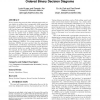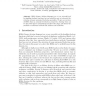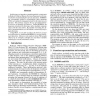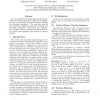CCS
2006
ACM
14 years 10 months ago
2006
ACM
Privacy-preserving protocols allow multiple parties with private inputs to perform joint computation while preserving the privacy of their respective inputs. An important cryptogr...
DEXA
2004
Springer
14 years 10 months ago
2004
Springer
As their field of application has evolved and matured, the importance of verifying knowledge-based systems is now widely recognized. Nevertheless, some problems have remained. In t...
ICCTA
2007
IEEE
14 years 10 months ago
2007
IEEE
We have carried out experimental research into implicit representation of large graphs using reduced ordered binary decision diagrams (OBDDs). We experimentally show that for grap...
ISMIS
1994
Springer
14 years 10 months ago
1994
Springer
BDDs (binary decision diagrams) are a very succesful tool for handling boolean functions, but one which has not yet attracted the attention of many automated deduction specialists....
DAC
1994
ACM
14 years 10 months ago
1994
ACM
Functional and timing verification are currently the bottlenecks in many design efforts. Simulation and emulation are extensively used for verification. Formal verification is now...
CCL
1994
Springer
14 years 10 months ago
1994
Springer
Abstract. We compare two prominent decision procedures for propositional logic: Ordered Binary Decision Diagrams (obdds) and the DavisPutnam procedure. Experimental results indicat...
DAC
1996
ACM
14 years 10 months ago
1996
ACM
Abstract-- It is impractical to verify multiplier or divider circuits entirely at the bit-level using ordered Binary Decision Diagrams (BDDs), because the BDD representations for t...
GLVLSI
1996
IEEE
14 years 10 months ago
1996
IEEE
Inthispaperweintroduceanondeterministiccounterpart to Reduced, Ordered Binary Decision Diagrams for the representation and manipulation of logic functions. ROBDDs are conceptually...
DAC
1997
ACM
14 years 10 months ago
1997
ACM
In many computer-aided design tools, binary decision diagrams (BDDs) are used to represent Boolean functions. To increase the efficiency and capability of these tools, many algor...
ICCAD
1997
IEEE
14 years 10 months ago
1997
IEEE
In many veri cation techniques fast functional evaluation of a Boolean network is needed. We investigate the idea of using Binary Decision Diagrams
BDDs
for functional simulatio...




